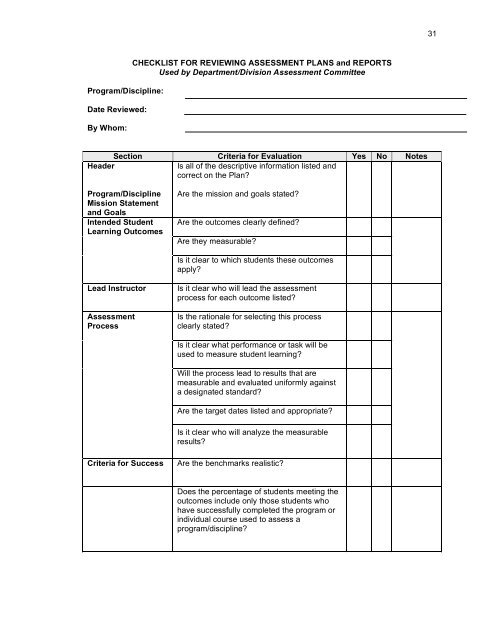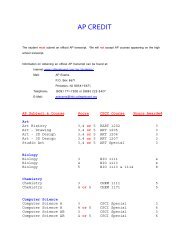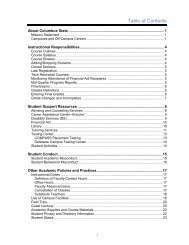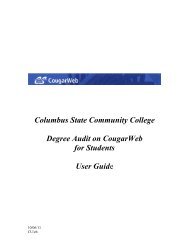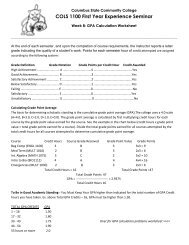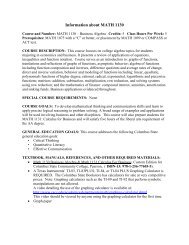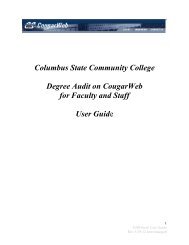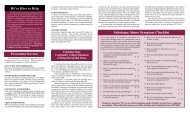Checklist for Reviewing Assessment Plans and Reports
Checklist for Reviewing Assessment Plans and Reports
Checklist for Reviewing Assessment Plans and Reports
Create successful ePaper yourself
Turn your PDF publications into a flip-book with our unique Google optimized e-Paper software.
31<br />
Program/Discipline:<br />
Date Reviewed:<br />
By Whom:<br />
CHECKLIST FOR REVIEWING ASSESSMENT PLANS <strong>and</strong> REPORTS<br />
Used by Department/Division <strong>Assessment</strong> Committee<br />
Section Criteria <strong>for</strong> Evaluation Yes No Notes<br />
Header<br />
Is all of the descriptive in<strong>for</strong>mation listed <strong>and</strong><br />
correct on the Plan?<br />
Program/Discipline<br />
Mission Statement<br />
<strong>and</strong> Goals<br />
Intended Student<br />
Learning Outcomes<br />
Are the mission <strong>and</strong> goals stated?<br />
Are the outcomes clearly defined?<br />
Are they measurable?<br />
Is it clear to which students these outcomes<br />
apply?<br />
Lead Instructor<br />
<strong>Assessment</strong><br />
Process<br />
Is it clear who will lead the assessment<br />
process <strong>for</strong> each outcome listed?<br />
Is the rationale <strong>for</strong> selecting this process<br />
clearly stated?<br />
Is it clear what per<strong>for</strong>mance or task will be<br />
used to measure student learning?<br />
Will the process lead to results that are<br />
measurable <strong>and</strong> evaluated uni<strong>for</strong>mly against<br />
a designated st<strong>and</strong>ard?<br />
Are the target dates listed <strong>and</strong> appropriate?<br />
Is it clear who will analyze the measurable<br />
results?<br />
Criteria <strong>for</strong> Success<br />
Are the benchmarks realistic?<br />
Does the percentage of students meeting the<br />
outcomes include only those students who<br />
have successfully completed the program or<br />
individual course used to assess a<br />
program/discipline?
32<br />
Section Criteria <strong>for</strong> Evaluation Yes No Notes<br />
Are the listed results quantifiable?<br />
Summary of Results<br />
<strong>and</strong> Analysis of Data<br />
Collected<br />
Are the results analyzed <strong>and</strong> interpreted in<br />
ways consistent with the overall plan?<br />
Action Plan Based<br />
on Results of<br />
Analysis<br />
Is it clear what was learned from the<br />
assessment process?<br />
Will the action plan close the assessment<br />
loop? Is it clear what steps will be taken to<br />
improve student learning?<br />
The Division <strong>Assessment</strong> Committee will maintain a record (matrix) of assessment<br />
plans <strong>and</strong> reports of Submitted <strong>and</strong> Accepted <strong>Plans</strong> submitted by each<br />
program/department by date <strong>and</strong> by department/program.<br />
A copy of this matrix will be <strong>for</strong>warded to the College <strong>Assessment</strong> Committee.
33<br />
Bloom’s Taxonomy<br />
Knowledge Comprehension Application Analysis Synthesis Evaluation<br />
(Remember) (Underst<strong>and</strong>) (Apply) (Analyze) (Evaluate) (Create)<br />
Count<br />
Define<br />
Describe<br />
Draw<br />
Label<br />
List<br />
Match<br />
Name<br />
Outline<br />
Point<br />
Quote<br />
Read<br />
Recall<br />
Recite<br />
Recognize<br />
Record<br />
Repeat<br />
Reproduces<br />
Selects<br />
State<br />
Write<br />
Memorize<br />
Arrange<br />
Duplicate<br />
Order<br />
Relate<br />
Tabulate<br />
Associate<br />
Classify<br />
Compute<br />
Contrast<br />
Convert<br />
Defend<br />
Describe<br />
Differentiate<br />
Discuss<br />
Distinguish<br />
Estimate<br />
Explain<br />
Extend<br />
Extrapolate<br />
Generalize<br />
Give examples<br />
Infer<br />
Identify<br />
Indicate<br />
Interpret<br />
Locate<br />
Paraphrase<br />
Predict<br />
Report<br />
Restate<br />
Review<br />
Rewrite<br />
Translate<br />
Add<br />
Apply<br />
Calculate<br />
Change<br />
Choose<br />
Classify<br />
Complete<br />
Compute<br />
Demonstrate<br />
Discover<br />
Divide<br />
Employ<br />
Examine<br />
Experiment<br />
Graph<br />
Interpolate<br />
Manipulate<br />
Modify<br />
Operate<br />
Per<strong>for</strong>m<br />
Practice<br />
Prepare<br />
Produce<br />
Relate<br />
Research<br />
organize<br />
Schedule<br />
Service utilize<br />
Show<br />
Sketch<br />
Solve<br />
Subtract<br />
Translate<br />
Troubleshoot<br />
Use<br />
Write<br />
Analyze<br />
Application<br />
Appraise<br />
Breakdown<br />
Calculate<br />
Categorize<br />
Combine<br />
Compare<br />
Connect<br />
Contrast<br />
Criticize<br />
Design<br />
Detect<br />
Diagram<br />
Differentiate<br />
Discriminate<br />
Distinguish<br />
Examine<br />
Experiment<br />
Explain<br />
Infer<br />
Outline<br />
Point out<br />
Question<br />
Relate<br />
Select<br />
Select<br />
Separate<br />
Subdivide<br />
Test<br />
Utilize<br />
Arrange<br />
Assemble<br />
Categorize<br />
Collect<br />
Combine<br />
Compile<br />
Compose<br />
Construct<br />
Create<br />
Design<br />
Develop<br />
Devise<br />
Drive<br />
Explain<br />
Formulate<br />
Generalize<br />
Generate<br />
Group<br />
Integrate<br />
Invent<br />
Formulate<br />
Manage<br />
Manage<br />
Modify<br />
Order<br />
Organize<br />
Plan<br />
Prepare<br />
Prepare<br />
Prescribe<br />
Propose<br />
Rearrange<br />
Reconstruct<br />
Related<br />
Reorganize<br />
Revise<br />
Rewrite<br />
Setup<br />
Specify<br />
Substitute<br />
Summarize<br />
Trans<strong>for</strong>m<br />
Appraise<br />
Arbitrate<br />
Argue<br />
Assess<br />
Attach<br />
Award<br />
Choose<br />
Compare<br />
Conclude<br />
Conclude<br />
Contrast<br />
Convince<br />
Core<br />
Criticize<br />
Critique<br />
Decide<br />
Defend<br />
Determine<br />
Discriminate<br />
Evaluate<br />
Explain<br />
Grade<br />
Interpret<br />
Judge<br />
Justify<br />
Measure<br />
Predict<br />
Prioritize<br />
Rank<br />
Rate<br />
Recommend<br />
Referee<br />
Reject<br />
Select<br />
Summarize<br />
Support<br />
Test<br />
Value
34<br />
Program Outcomes Validation <strong>and</strong> General Education Outcomes Validation<br />
This step of the process seeks to determine if program <strong>and</strong> general education outcomes are<br />
appropriate to meeting current academic, business, trade, <strong>and</strong>/or professional/technological<br />
st<strong>and</strong>ards.<br />
Validation studies <strong>and</strong> reports are required of all department/programs every three years.<br />
These reports are submitted to the Division <strong>Assessment</strong> Committee <strong>and</strong> then to the<br />
College <strong>Assessment</strong> Committee. Feedback is provided from the department, division, <strong>and</strong><br />
college committees.<br />
Program Revision<br />
The faculty <strong>and</strong> department chair decide on appropriate revisions to the program based on data<br />
received from internal <strong>and</strong> external review. Changes to the curriculum are implemented to<br />
enhance student academic achievement. Such changes may include, but are not limited to<br />
• devoting more class or lab time to assisting students with difficult content or skill areas, <strong>for</strong><br />
example, increasing/decreasing lab/lecture hours;<br />
• changing a program’s course sequence to better prepare students <strong>for</strong> higher-level academic<br />
<strong>and</strong> technical knowledge <strong>and</strong> skills;<br />
The data obtained through assessment activities will be shared <strong>and</strong> reviewed at multiple levels<br />
across the College including departments, divisions, <strong>and</strong> campus-wide via the College<br />
<strong>Assessment</strong> Committee. These reviews are designed to provide support <strong>for</strong> implementation of the<br />
assessment model through the sharing of best practices <strong>and</strong> the celebration of documented<br />
improvement in student academic achievement.
35<br />
Columbus State Community College<br />
Schedule of Program <strong>and</strong> General Education Learning Outcomes Validation<br />
Three-Year Cycle: 2006-2007, 2007-2008, 2008-2009<br />
2006-2007 2007-2008 2008-2009<br />
Aviation Maintenance<br />
Business Management<br />
Electro-Mechanical Eng.<br />
Finance<br />
HVAC<br />
HIMT<br />
HRM<br />
Law En<strong>for</strong>cement<br />
Legal Assisting<br />
Medical Laboratory<br />
Massage Therapy<br />
Mechanical Engineering<br />
Medical Assisting<br />
Multi-Competency Health<br />
Quality Assurance<br />
Radiography<br />
Surgical Tech<br />
Tech Communications (AS)<br />
Veterinary<br />
Web Developer (CIT) Moved 07-08<br />
Accounting<br />
Automotive<br />
Dental Hygiene<br />
Emergency Medical Services<br />
EET<br />
Environmental<br />
Fire Science<br />
Interactive Multimedia<br />
ITT/ASL<br />
L<strong>and</strong>scape Design/Build<br />
Marketing<br />
Network Admin (CIT)<br />
Real Estate<br />
Sport & Exercise Studies<br />
User Support (CIT)<br />
Nursing<br />
Web Developer (CIT)<br />
Architecture<br />
Civil Engineering<br />
Construction Management<br />
ECD<br />
GIS<br />
Graphic Communications<br />
Hospitality<br />
Logistics<br />
MH/CD/MR<br />
Nuclear Medicine<br />
OADM<br />
Respiratory Care<br />
Software Developer (CIT)<br />
General Education Outcomes<br />
CSCC Program <strong>and</strong> General Education Learning Outcomes Validation Report Time Line<br />
September to June ............................................ Department Study<br />
July 15 or next business day ............................ Submit hard <strong>and</strong> e-copy to Division <strong>Assessment</strong> Committee<br />
October 1 or next business day........................ Submit to <strong>Assessment</strong> Committee (Instructional Council)<br />
November 1 or next business day.................... Office of <strong>Assessment</strong><br />
December 1 or next business day.................... Provost’s Office<br />
Review of the Program Outcomes Validation Report<br />
The respective Division <strong>Assessment</strong> Committee reviews the Program Outcomes Validation<br />
<strong>Reports</strong>, provides feedback to the department, prepares a summary, <strong>and</strong> <strong>for</strong>wards the<br />
reports (electronically <strong>and</strong> paper), <strong>and</strong> summary to the College <strong>Assessment</strong> Committee.<br />
The College <strong>Assessment</strong> Committee reviews the Program Outcomes Validation Report<br />
Summary <strong>and</strong> provides feedback to the Divisional <strong>Assessment</strong> Committees, submits an<br />
Executive Summary Report to the Provost of Learning Systems <strong>and</strong> to the President of the<br />
College, <strong>and</strong> then communicates the assessment results to the campus community.
36<br />
Validation Process <strong>and</strong> Reporting Format<br />
<strong>for</strong> Program Outcome Validation <strong>and</strong> General Education Outcomes Validation<br />
3-Year Process<br />
The following pages give an explanation of the SECTIONS of the Validation Report.<br />
Introductory In<strong>for</strong>mation—Fill in the in<strong>for</strong>mation<br />
Department/Program/Discipline Name<br />
Department Chair<br />
Program Coordinator or Faculty Participating in the Study<br />
Date Submitted<br />
Department Mission Statement<br />
Department Goals<br />
Program Outcomes<br />
TITLE PAGE<br />
SECTION 1: Program/Discipline Profile<br />
Recommendations <strong>and</strong> Suggestions<br />
SECTION 2: Review Resources<br />
Recommendations <strong>and</strong> Suggestions (Summary of Validation Process<br />
(Include which methods were external <strong>and</strong> which methods were internal.)<br />
SECTION 3: Action Plan <strong>and</strong> Summary of Student Learning Outcomes<br />
EXECUTIVE SUMMARY Description of Methods Used to Validate Program Outcomes<br />
SECTION 4: Results of Program Outcomes Validation Process<br />
SECTION 5: Implications of Results <strong>and</strong> Specific <strong>Plans</strong> <strong>for</strong> Revision of Curriculum <strong>and</strong>/or<br />
Program Outcomes as Indicated<br />
RECOMMENDED STEPS AND TIMELINE FOR COMPLETING THE PROCESS<br />
SUMMER QUARTER<br />
To begin your Program Outcomes Validation, obtain the following in<strong>for</strong>mation from<br />
Knowledge Resources & Planning website to assist you in describing your students <strong>and</strong><br />
discipline profile:<br />
• Unduplicated Discipline Enrollment Profile<br />
• Program Related Student Profile<br />
• Number of Degrees <strong>and</strong> Number of Certificates Awarded<br />
• FTEs<br />
• Graduate Survey Summary<br />
• Transfer Data<br />
• Retention data<br />
AUTUMN AND WINTER QUARTERS<br />
Review PROGRAM LEARNING OUTCOMES as stated in the catalog to determine they are<br />
measurable (Refer to Bloom’s Taxonomy <strong>for</strong> action words).<br />
Do your program outcomes:<br />
• measure multiple levels of learning?<br />
• support Columbus State Community College’s mission?;
37<br />
• match with General Education outcomes at CSCC?<br />
• identify the knowledge <strong>and</strong> skills expected of graduates of the program, <strong>and</strong> what they<br />
will do when they graduate not individual course outcomes?<br />
Are your program outcomes:<br />
• consistent with expectations of employers, transfer institutions, entering students, <strong>and</strong> the<br />
needs of the communities of interest?<br />
• consistent with the purpose of the program as stated in the catalog?<br />
Remember that a program outcome is broad <strong>and</strong> may address a number of courses <strong>and</strong><br />
outcomes. Limit the number of program outcomes.<br />
REVIEW current CURRICULUM <strong>and</strong> DESCRIBE your STUDENTS<br />
• Check courses <strong>for</strong> logical sequence<br />
• No duplicate content except as needed <strong>for</strong> rein<strong>for</strong>cement<br />
• Consider emerging issues in the field or discipline<br />
• Evaluate the curriculum—is it comprehensive enough to meet the goals of the program<br />
<strong>and</strong> general education<br />
• Recommend changes in the curriculum as appropriate. (This will provide questions <strong>for</strong><br />
you during the validation <strong>for</strong> evidence that these changes need to be addressed.)<br />
• Identify degrees <strong>and</strong> certificates included in the program—describing if there is a good<br />
mix of degrees, specializations, certificates, distance learning, etc.<br />
• Identify strengths <strong>and</strong> weaknesses of the curriculum that support programs other than the<br />
one being evaluated<br />
• Review relationships with high schools (dual enrollment, tech prep) <strong>and</strong> colleges (articulation<br />
agreements)<br />
• Describe the needs of your current students.<br />
EVALUATE MEASURES of STUDENT LEARNING that you are using.<br />
Use the course-embedded assessments first. Go over tests, exams, reading assignments, oral<br />
presentations, capstone courses, etc., to make sure that they assess student learning outcomes.<br />
Consider additional assessments you will carry out. You might look at transfer success data <strong>and</strong><br />
employment/placement rates.<br />
Measure the PROGRAM LEARNING OUTCOMES<br />
A variety of methods should be used to evaluate the Program Learning Outcomes at program<br />
completion. The following are just a few examples:<br />
INTERNAL<br />
Department Review Committee<br />
Literature Review<br />
Exit Interview of Students<br />
Exit Survey of Students<br />
EXTERNAL<br />
DACUM (In<strong>for</strong>mation available in the <strong>Assessment</strong> Office)<br />
Employer Survey<br />
Graduate Survey<br />
Special Interest Groups Survey or Interviews<br />
Success of Transfer Students<br />
Advisory Committee<br />
Accreditation Process
38<br />
Focus Group<br />
Industry Representatives<br />
Results of Licensing Exam<br />
Survey Like-Colleges<br />
Survey institutions where articulations are held or are pending/possible<br />
SECTION 1 OF THE REPORT<br />
WRITE THE INTRODUCTION<br />
PROGRAM/DISCIPLINE PROFILE INCLUDING<br />
• Degree, specialization, <strong>and</strong> certificates included in the program<br />
• A narrative description of the program<br />
• Courses that support programs other than the one being evaluated<br />
• A description of your current students—contact KR&P website <strong>for</strong> current data<br />
• Specific industries or businesses served by the program<br />
• Institutions to which your current students transfer<br />
• Emerging trends in your field or discipline<br />
• Significant developments since the last evaluation<br />
The introduction should include a summary of the current curriculum, not a listing of<br />
courses that are found in the catalog.<br />
SPRING QUARTER<br />
Collection <strong>and</strong> analysis of data begins<br />
Program learning outcomes are the primary focus<br />
Prepare Recommendations <strong>for</strong> Revision of the Curriculum<br />
As the results of the assessment of student learning are analyzed, you may begin to see the need<br />
to revise the curriculum <strong>and</strong> teaching strategies. Is the curriculum working <strong>for</strong> the students? Are<br />
they prepared when they enter the workplace or transfer to a 4-year institution? Meet your<br />
ADVISORY COMMITTEES <strong>and</strong> the like to discuss the curriculum. These committees involve<br />
constituents who underst<strong>and</strong> the relationships among the courses of study, the currency of the<br />
curriculum, <strong>and</strong> the utility of the knowledge <strong>and</strong> skills gained.<br />
If you conducted employer satisfaction surveys last quarter, decide what curricular revisions are<br />
indicated by your findings. For transfer programs, carefully consider transfer data on the success<br />
of CSCC students at 4-year institutions.<br />
SECTION 2 OF REPORT<br />
REVIEW RESOURCES<br />
Review the adequacy of resources <strong>for</strong> your program. In any case where you consider the<br />
resources that support your program to be inadequate, you must justify that judgment by<br />
evidence that student learning is adversely affected. Consider the support personnel working in<br />
the program as well as the instructional <strong>and</strong> institutional academic support services that are<br />
unique <strong>and</strong> critical to your program. Are the classrooms <strong>and</strong> laboratory facilities adequate? If not,
39<br />
what do you recommend to make them adequate? Is the library collection available adequate? If<br />
not, consult with the librarians to determine what needs to be done to improve the holding. What<br />
about equipment <strong>and</strong> supplies? Again, if the data indicates that they are inadequate, you need to<br />
describe what you recommend to improve the situation.<br />
Evaluate Instructional Approaches<br />
Describe the various instructional approaches that students experience in your program or<br />
discipline. Highlight or showcase those that have been particularly effective in producing<br />
student learning. Describe how you know that these approaches were effective in producing<br />
student learning. Consider how you meet the differing learning styles of students in your program.<br />
Describe how the instructional approaches are appropriate to the purpose of the program <strong>and</strong> the<br />
goals of the program or discipline. If students have access to your courses through various<br />
distance learning opportunities <strong>and</strong> instructional delivery systems such as web-based courses,<br />
<strong>and</strong> computer-based courses, describe how student learning is assessed in these courses.<br />
SPRING QUARTER<br />
SUMMARY OF PROGRAM LEARNING OUTCOMES<br />
The assessment of student learning outcomes is at the heart of the program validation. Be<strong>for</strong>e<br />
you finalize your report, complete a summary of what you have learned about student<br />
learning in your program. In the summary, indicate the following:<br />
1. what learning outcomes (either program outcomes or general education outcomes, or<br />
both) were assessed<br />
2. the method by which the assessment was done<br />
3. the assessment outcome<br />
4. recommendations based on your assessment<br />
5. copy of your FORMATIVE AND SUMMATIVE CHART<br />
6. actions to be taken to improve student learning<br />
This summary will <strong>for</strong>m the basis <strong>for</strong> your Action Plan <strong>and</strong> will be included along with a copy of<br />
the Executive Summary <strong>and</strong> Action Plan sent to the Division <strong>Assessment</strong> Committees <strong>and</strong><br />
<strong>Assessment</strong> <strong>and</strong> Curriculum Directors. It will also be included in the ANNUAL ASSESSMENT<br />
REPORT to the provost prepared by the College <strong>Assessment</strong> Committee.<br />
On the next page you will find an example of what a PROGRAM LEARNING OUTCOMES<br />
SUMMARY might look.
40<br />
WRAPPING IT UP<br />
Revise Goals<br />
Now that you have assessed student learning <strong>and</strong> evaluated the curriculum, instructional<br />
modalities, <strong>and</strong> resources, you may find that your program or discipline outcomes need to be<br />
revised. Be sure to include your revised goals <strong>and</strong> outcomes in your final report <strong>and</strong> include the<br />
general education outcomes <strong>for</strong> your program. You may key these in a table with the Existing<br />
Outcomes in one column <strong>and</strong> the Proposed in the next column.<br />
Complete the Final Draft of the Validation Report<br />
It will be helpful to have an outside reader review your report at this time to help you strengthen it<br />
as well as to help spot areas where additional data may be useful; the director of assessment or a<br />
designee from the division or college assessment committees.<br />
SECTION 3<br />
TIME TO WRITE THE ACTION PLAN<br />
AND SUMMARY OF STUDENT LEARNING OUTCOMES<br />
As the results of the various assessments are analyzed; recommendations based on the findings<br />
will start to cluster. You should include a section in your report that describes actions taken to<br />
improve the program or discipline during the evaluation process <strong>and</strong> provide an ACTION PLAN<br />
to accomplish the recommendations <strong>and</strong> suggestions you make.<br />
As the recommendations <strong>and</strong> suggestions emerge, so will your Action Plan. Resist the urge to<br />
write the ACTION PLAN be<strong>for</strong>e all the assessments are completed <strong>and</strong> recommendations are<br />
made. Recommendations <strong>and</strong> suggestions should be placed throughout the report where the<br />
supporting data is reported. Make sure that each recommendation <strong>and</strong> suggestion is clearly<br />
supported by the evidence you present. It is very helpful (both to you as you write the report as<br />
well as the report readers later) to list all recommendations <strong>and</strong> suggestions made at the end<br />
of the chapter in which they appear. Each recommendation <strong>and</strong> suggestion that you make<br />
throughout the report must also appear as part of your action plan.<br />
A RECOMMENDATION describes an action that will be taken to achieve the goals <strong>and</strong> outcomes<br />
of the program or discipline <strong>and</strong> to make the program effective. The recommendations must be<br />
tied to supporting evidence in your report <strong>and</strong> must be directly <strong>and</strong> clearly related to the goals <strong>and</strong><br />
outcomes of your program or discipline. Recommendations are to be related to program or<br />
discipline specific issues, not college-wide policies <strong>and</strong> procedures, <strong>and</strong> include an action to be<br />
taken, a rationale <strong>for</strong> the action, the title of the person responsible <strong>for</strong> taking the action, <strong>and</strong> a<br />
due date.<br />
Your chair or program coordinator will report on the implementation of your ACTION PLAN one<br />
year after it is approved by the <strong>Assessment</strong> Committee. There<strong>for</strong>e, recommendations should<br />
address those areas where you have some control <strong>and</strong> influence. Do not, <strong>for</strong> example, indicate<br />
that an action must be taken by "the college," but name the person who will be responsible <strong>and</strong><br />
accountable <strong>for</strong> carrying out the recommended action. Finally, remember this is your Action Plan.<br />
It will detail what you <strong>and</strong> your colleagues plan to do to improve the effectiveness of your<br />
program.<br />
A SUGGESTION describes an action that should be taken to improve the program's or<br />
discipline's effectiveness. Each suggestion must also define a plan <strong>for</strong> action in the same way a<br />
recommendation does. Obviously, suggestions are not as strong as recommendations <strong>and</strong><br />
there<strong>for</strong>e should define areas that while not crucial to the effectiveness of a program or discipline<br />
would, if carried out, enhance it.
41<br />
The following <strong>for</strong>mat is recommended <strong>for</strong> each<br />
recommendation <strong>and</strong> suggestion in your action plan:<br />
RECOMMENDATION: Include the page number in the report where it appears.<br />
RATIONALE: The evidence from your report that supports the recommendation or suggestion.<br />
ACTION TO BE TAKEN: This should be specific in nature. Just what, exactly, is to be done?<br />
RESPONSIBILITY Name a single person (or position) as the responsible party (<strong>and</strong> it should be<br />
someone who you have influence since this is, after all, your action plan).<br />
DATE BY: Be realistic here. The wheels of academe grind slowly.<br />
Write the Executive Summary<br />
The intent of the EXECUTIVE SUMMARY is to allow readers from a variety of audiences to focus<br />
immediately on the most important finding of your review. Your summary should be concise <strong>and</strong><br />
done by chapter <strong>and</strong>/or section allowing readers to find the part of your review that may hold<br />
particular interest <strong>for</strong> them.<br />
Finalize the Review Report<br />
After you have completed the report, send an e-copy to the Chair of the Division <strong>Assessment</strong><br />
Committee <strong>and</strong> to the Director of <strong>Assessment</strong>. Since each Division <strong>Assessment</strong> Committee,<br />
Instructional Council <strong>Assessment</strong> Committee, has responsibility <strong>for</strong> the program being evaluated<br />
must be given an opportunity to review <strong>and</strong> comment on the report, copies will be sent to them<br />
along with a comment sheet. A copy of all completed comment sheets will be sent to the chair of<br />
your department.<br />
In addition to the main body, the final report will include a TITLE PAGE listing the members of<br />
the review committee, Provost’s <strong>and</strong> Division Committee/Dean’s Comment Pages, an<br />
Executive Summary, F & S Chart, <strong>and</strong> the Student Learning Outcomes Summary, the<br />
Evaluation, <strong>and</strong> any Appendices you feel are essential to the underst<strong>and</strong>ing of the report. The<br />
report is due July 15 of the respective year. Be judicious in what you choose to include in the<br />
appendices <strong>and</strong> include only what is absolutely necessary <strong>for</strong> a clear underst<strong>and</strong>ing of your<br />
report. Overly large appendices are not encouraged due to storage space <strong>and</strong> in general are not<br />
circulated unless specifically requested by a reader. Include minutes of meetings (only) where<br />
program outcomes were discussed or relative in<strong>for</strong>mation to the study.<br />
Your report will then be read by two persons chosen from the Instructional Council <strong>Assessment</strong><br />
<strong>and</strong> Curriculum Committees. These readers will provide you with written comments on your<br />
report. The Executive Summary, Student Learning Outcomes Summary, <strong>and</strong> Action Plan<br />
will be <strong>for</strong>warded to the <strong>Assessment</strong> Committees. You will be invited to attend the meeting at<br />
which your report will be discussed.<br />
The readers will be asked to present their comments to the <strong>Assessment</strong> <strong>and</strong> Curriculum<br />
Committee. The committee members may have questions to ask you about the report <strong>and</strong> may<br />
recommend amendments to the Action Plan. Finally, the Action Plan is <strong>for</strong>warded to the Provost<br />
<strong>for</strong> approval. You will be notified by the Director of <strong>Assessment</strong> when your Action Plan has been<br />
approved.<br />
The deans of Student Life <strong>and</strong> Student Services will be sent the Action Plan <strong>and</strong> asked to<br />
share it with the advisors <strong>and</strong> counselors. The report you’re your findings <strong>and</strong> your Action<br />
Plan will be reported to the College <strong>and</strong> Board of Trustees in the Annual <strong>Assessment</strong><br />
Report.
42<br />
General Education Outcomes Validation<br />
Validate General Education Outcomes Internally<br />
1. The General Education <strong>Assessment</strong> Committee is comprised of faculty representatives<br />
from each division. The Committee validates the general education outcomes using<br />
broad-based involvement by faculty, staff, <strong>and</strong> administrators. The validation process<br />
seeks both internal <strong>and</strong> external input in reviewing <strong>and</strong> revising the general education<br />
outcomes.<br />
2. The General Education <strong>Assessment</strong> Committee reviews the general education outcomes<br />
as printed in the College Catalog <strong>and</strong> determines if they are current. For a statement to<br />
qualify as an outcome, the College must be able to prove by some measure that, upon<br />
completion of the program, the student has achieved the stated outcome. General<br />
education outcomes reflect current knowledge, skills, attributes, <strong>and</strong> st<strong>and</strong>ards faculty<br />
believe enhance the college learning experience <strong>and</strong> provide necessary skills to prepare<br />
the student <strong>for</strong> future studies or employment. The general education outcomes must be<br />
measurable.<br />
3. The General Education <strong>Assessment</strong> Committee reviews the data on general education<br />
outcomes provided in the Program Validation <strong>Reports</strong> to determine the degree to which<br />
the general education outcomes, as printed in the College Catalog, are deemed valid by<br />
the degree granting programs.<br />
Validate General Education Outcomes Externally<br />
In addition to the above-noted committee review of general education outcomes (Internal<br />
Review), general education validation activities must also include an independent review of the<br />
general education outcomes by discipline or subject-area experts not directly affiliated with the<br />
College.<br />
1. The General Education <strong>Assessment</strong> Committee documents that general education<br />
outcomes are valid by:<br />
demonstrating that the outcomes are current <strong>and</strong> desired by faculty as well as other<br />
stakeholders;<br />
demonstrating that the general education skills <strong>and</strong> abilities taught are what<br />
employers are looking <strong>for</strong> when they hire employees;<br />
ascertaining if there are general education skills <strong>and</strong> abilities needed that are not<br />
being taught;<br />
<strong>and</strong> demonstrating that skills <strong>and</strong> abilities taught in the general education outcomes<br />
are what students need to succeed at other institutions of higher education.<br />
2. The General Education <strong>Assessment</strong> Committee determines the validity of the general<br />
education outcomes of the institution by using one or more of the following external<br />
methods: programmatic outcomes-based accreditation, external evaluation by industry or<br />
professional focus groups, DACUMs, employer outcomes surveys, or other appropriate<br />
activities.<br />
Review <strong>and</strong> Revise Curriculum<br />
1. The General Education <strong>Assessment</strong> Committee reviews the results of the internal <strong>and</strong><br />
external validation reviews <strong>and</strong> makes changes to the outcomes. The Committee submits<br />
the proposed changes <strong>and</strong> current general education outcomes to faculty, college wide,<br />
to review. Based on feedback received, the General Education Committee may further<br />
revise the general education outcomes. The Committee has a final meeting with the
43<br />
faculty, campus wide, be<strong>for</strong>e submitting the final version of the General Education<br />
Outcomes Validation Report.<br />
The General Education <strong>Assessment</strong> Committee makes revisions to the general education<br />
outcomes as necessary; consults faculty <strong>for</strong> additional feedback concerning the<br />
appropriate revisions; <strong>and</strong> submits the Executive Summary to the College <strong>Assessment</strong><br />
Committee.<br />
The General Education <strong>Assessment</strong> Committee submits final recommendations <strong>for</strong><br />
changes to general education outcomes to the Governance Councils <strong>and</strong> committees <strong>for</strong><br />
approval.<br />
Documentation:<br />
The General Education Outcomes Validation Report is submitted every three years to<br />
the Arts <strong>and</strong> Sciences, Career <strong>and</strong> Technical Programs, <strong>and</strong> Community Education <strong>and</strong><br />
Work<strong>for</strong>ce Development Divisional <strong>Assessment</strong> Committees by July 15. The Report<br />
details the results of the Internal <strong>and</strong> External Reviews <strong>and</strong> describes changes that may<br />
be made to general education outcomes.<br />
The General Education Outcomes Validation Report must include a completed<br />
General Education Outcomes Matrix documenting the contributions of each course in<br />
the curriculum toward the teaching <strong>and</strong> learning of prescribed outcomes. Additionally, the<br />
General Education Outcomes Matrix should be updated <strong>and</strong> submitted annually with<br />
requested curriculum revisions.<br />
Changes to outcomes <strong>and</strong> curricula are requested as part of the College’s annual<br />
curriculum revision process using MCI <strong>for</strong>ms, course outlines, plans of study, <strong>and</strong> other<br />
approved documentation. The assessment data will provide evidence of data-driven<br />
decisions.


